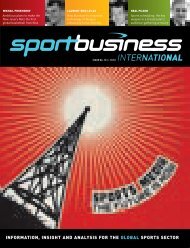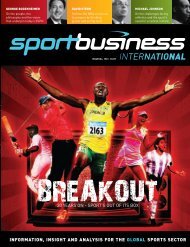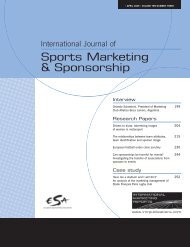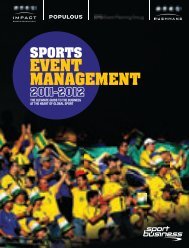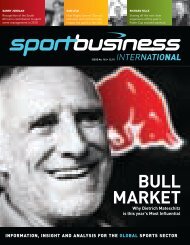01 cover sbi 152.indd - FIFA/CIES International University Network
01 cover sbi 152.indd - FIFA/CIES International University Network
01 cover sbi 152.indd - FIFA/CIES International University Network
Create successful ePaper yourself
Turn your PDF publications into a flip-book with our unique Google optimized e-Paper software.
MOTORSPORT:<br />
MEDIA<br />
Dale Earnhardt Jr in action -<br />
Getty Images Sport<br />
Storylines are the key to ratings spikes in motorsport<br />
since compelling, relevant dramas help it reach beyond<br />
the petrol-head audience. But Andy Fry dis<strong>cover</strong>s that<br />
consistency is also crucially important.<br />
THE ORTHODOX WISDOM is that<br />
fans spend more time at home<br />
during downturns because they<br />
can’t afford to go out; and that<br />
thesis certainly seems to have been<br />
borne out in the case of F1 which<br />
has delivered robust ratings across<br />
a range of territories. US stock car<br />
series Nascar the sector’s other bell<br />
weather franchise, has struggled by<br />
comparison though. So what’s the<br />
explanation<br />
While top motorsports<br />
franchises can usually be<br />
guaranteed to deliver a solid<br />
hardcore of viewers, the sheer<br />
range of digital media alternatives<br />
means that a genuine hook is now<br />
needed to boost TV ratings.<br />
For F1, this added incentive<br />
usually comes in three forms -<br />
race location, the performance<br />
of key individuals/teams and the<br />
competitiveness of the overall<br />
driver’s championships.<br />
The first point is underlined by<br />
the Mediametrie figures oppostite<br />
which show that TF1 France<br />
secured a 40 per cent share of<br />
audience for the 2009 Monaco<br />
Grand Prix - its highest rating of<br />
the year (at the time of writing<br />
before the Brazilian GP). Similarly,<br />
RAI Italy’s best figures came for<br />
the Italian Grand Prix (45 per<br />
cent share, 7.7 million). In other<br />
words, races close to home have a<br />
particular appeal to viewers.<br />
This point is even more<br />
accentuated in new F1 markets<br />
where news that a Grand Prix is<br />
on its way can have a ripple effect<br />
across the entire racing season.<br />
Take Singapore for example where<br />
ESPN Star Sports reported an<br />
increased appetite for the sport<br />
ahead of its debut GP in 2008.<br />
The most impressive figures came<br />
in the male 35-44 demographic,<br />
where audiences for live F1 races<br />
grew 127 per cent year-on-year<br />
(2008 vs 2007). Even among<br />
younger men figures were up<br />
around 20 per cent.<br />
While ESPNSS shows most<br />
F1 races, the Singapore GP itself<br />
is aired on domestic Englishlanguage<br />
network Channel 5.<br />
This year (2009), the race secured<br />
23.6 per cent of audience - which<br />
may not sound high until you<br />
consider a) it aired in primetime<br />
not daytime b) most viewing<br />
in Singapore goes to Chineselanguage<br />
Channel 8 and c) a highproportion<br />
of fans watch the race<br />
in bars. With all that in mind, the<br />
fact that the race was Channel 5’s<br />
12th best performer of the year (up<br />
to Sept 27) is pretty impressive.<br />
The impact on TV ratings of<br />
hosting a GP is only matched when<br />
one of the other key factors come<br />
into play. Take a look at the UK’s F1<br />
viewing figures, for example. Despite<br />
a five-hour time difference between<br />
the UK and the Americas, the<br />
Brazilian Grand Prix has delivered<br />
extremely strong ratings in the UK<br />
for both of the last two seasons.<br />
Home advantage<br />
The reason is simple. In both cases,<br />
the race has delivered a British<br />
World Champion - Lewis Hamilton<br />
in 2008 and Jenson Button in<br />
2009. In 2008, the race averaged<br />
8.8 milion viewers (41 per cent<br />
share) and peaked at 12.5 million<br />
for commercial network ITV. In<br />
2009, it averaged 6.6 million (35<br />
per cent) and peaked at 8.9 million<br />
for new rights holder the BBC.<br />
The impact of driver<br />
personalities in motorsports has<br />
been evident for years. Ayrton<br />
Senna, Michael Schumacher,<br />
Fernando Alonso and Kimi<br />
Raikkonen have all had a dramatic<br />
impact on F1 viewing figures<br />
in their domestic markets. By<br />
contrast, the absence of a top talent<br />
- or their retirement - generally<br />
causes the reverse effect.<br />
This was certainly the case in<br />
Germany after Schumacher retired.<br />
And it’s possibly one reason why<br />
Nascar on Fox US saw the average<br />
rating for its first ten races in 2009<br />
drop to 5.4 (8.9 million viewers)<br />
from 6.1 (10 million) year-on-year,<br />
which analysts have, at least partly,<br />
attributed to the inconsistent<br />
performance of Nascar icon Dale<br />
Earnhardt Jr.<br />
Nascar is acutely aware of the<br />
point - with Nascar Media Group<br />
president Paul Brooks saying that<br />
2009 has suffered from a lack of<br />
“storylines” - since it is these which<br />
drive viewing momentum. Usually,<br />
Nascar can rely on set-piece events<br />
like the Daytona 500 to help turn<br />
things round. But this year the race<br />
was rain-shortened - with the result<br />
that the audience was down 10 per<br />
cent on the previous year’s race.<br />
As we’ve noted above, a good<br />
story will make audiences ignore<br />
time differences. But this isn’t the<br />
same as saying time differences<br />
don’t matter - they do. In F1,<br />
Bernie Ecclestone has grasped this<br />
point - which is why he encouraged<br />
Singapore to hold a night-race<br />
(since this suited European<br />
television audiences better). It has<br />
also been noted also how much<br />
difference rescheduling race times<br />
in the likes of Australia and Asia<br />
can make to European audiences.<br />
Of course, it’s not always an<br />
easy judgment to make changes.<br />
Looking again at Nascar, for<br />
example, there is an argument that<br />
moving ad breaks away from pit<br />
stops would boost ratings since<br />
Nascar fans like pit stops.<br />
52 SportBusiness <strong>International</strong> • No. 152 • 12.09



